Room-Temperature Electron Spin Generation by Femtosecond Laser Pulses in Colloidal CdS Quantum Dots
Abstract
:1. Introduction
2. Experimental

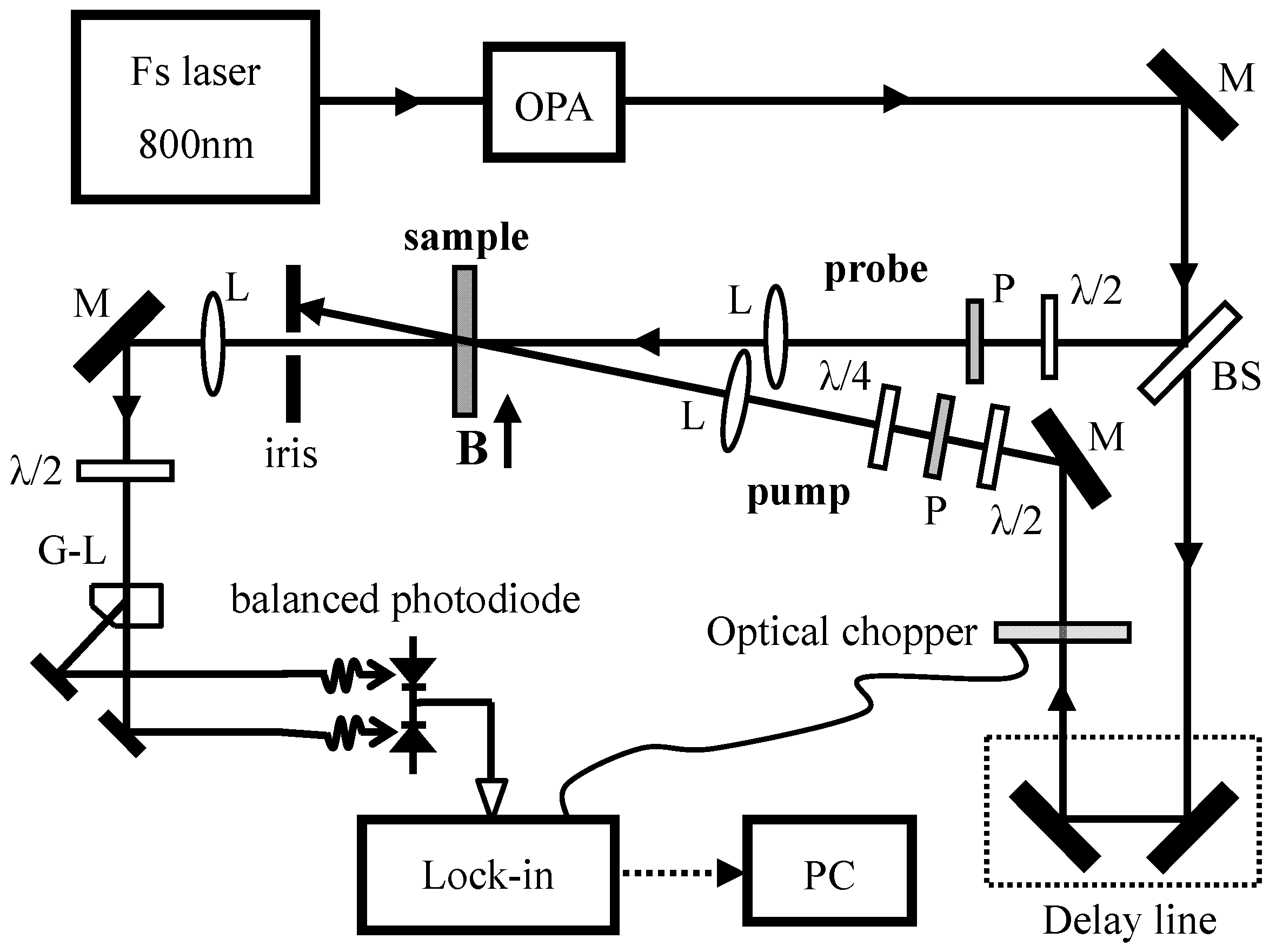
3. Results and Discussion
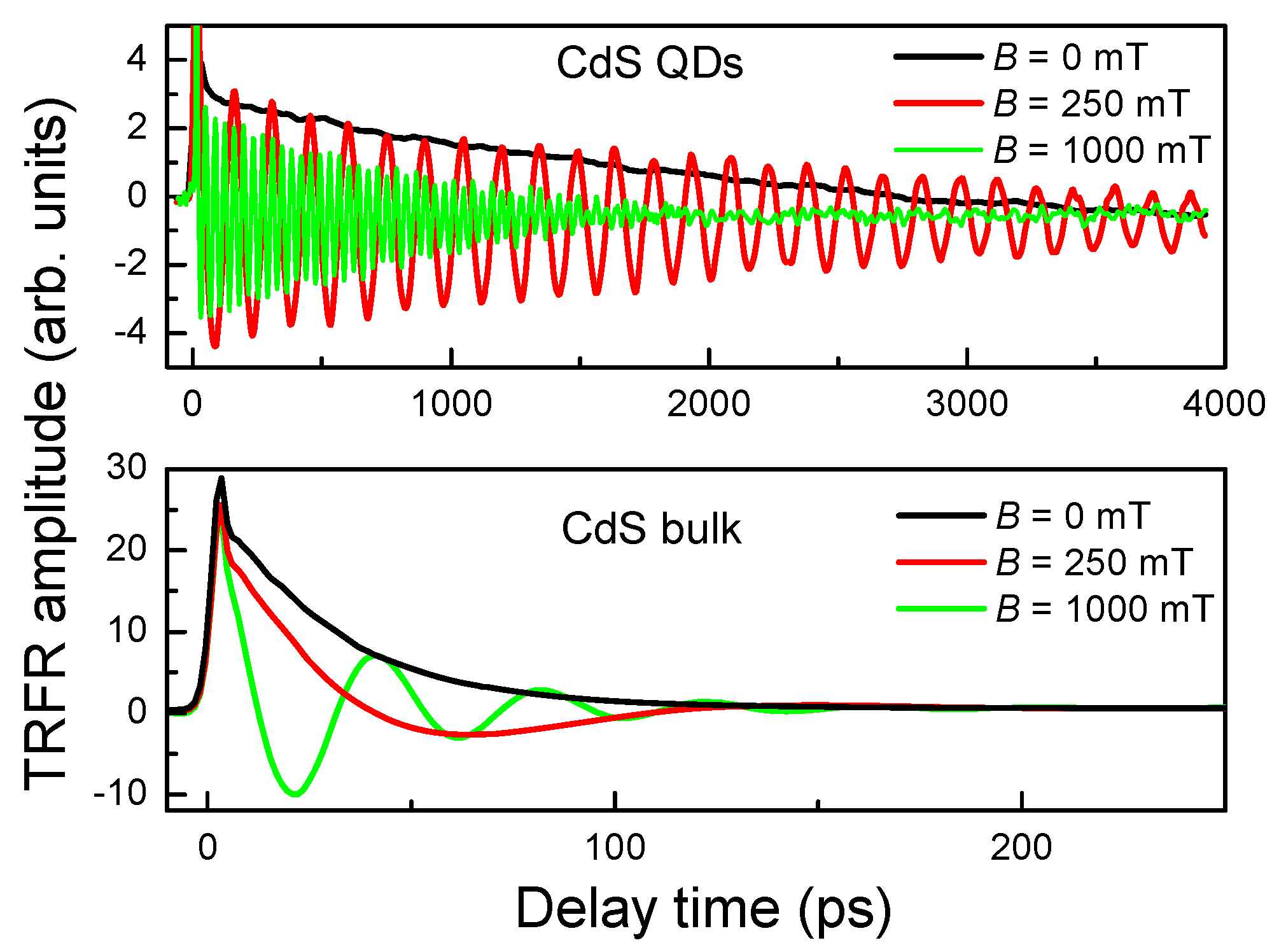
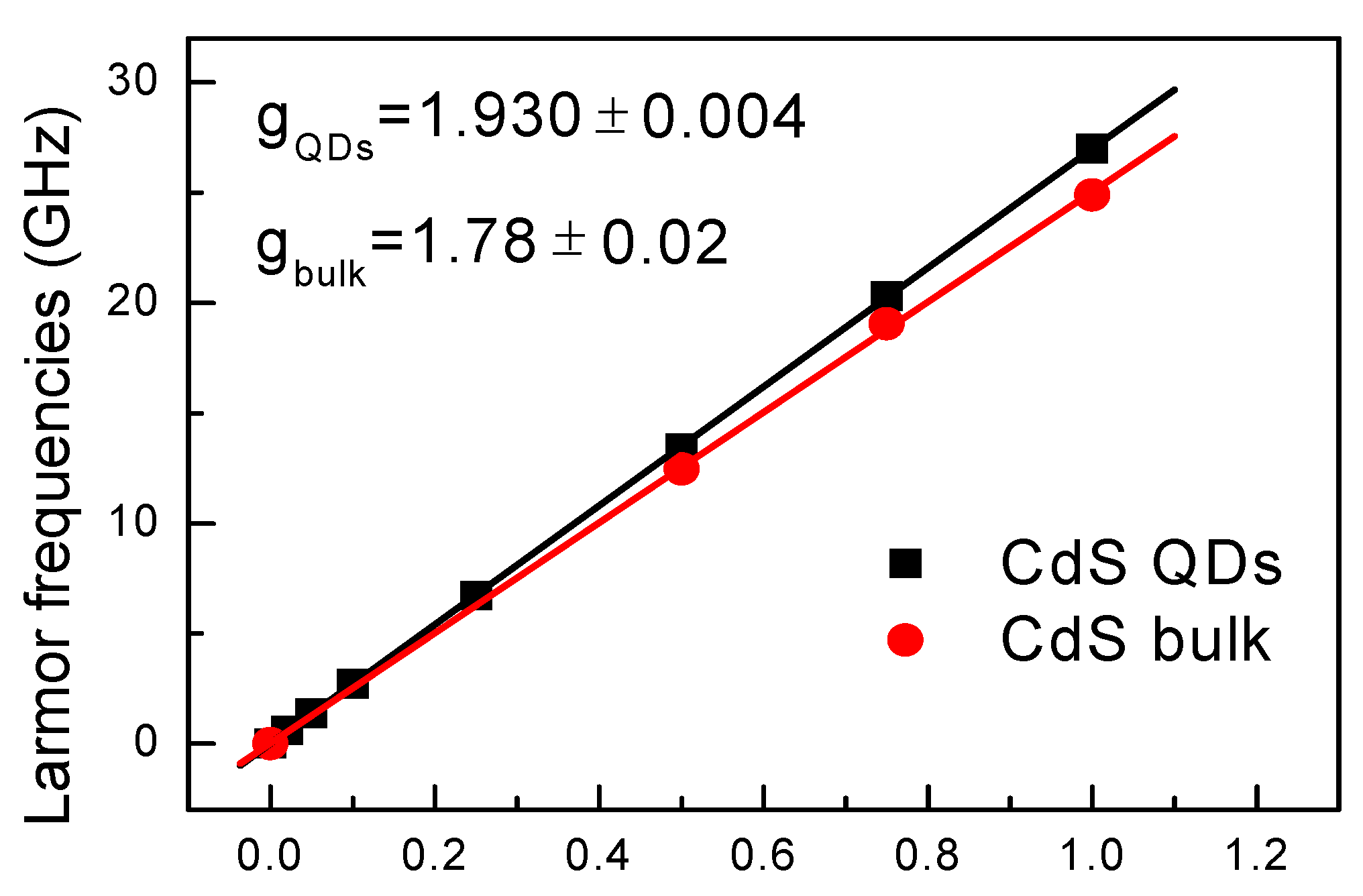
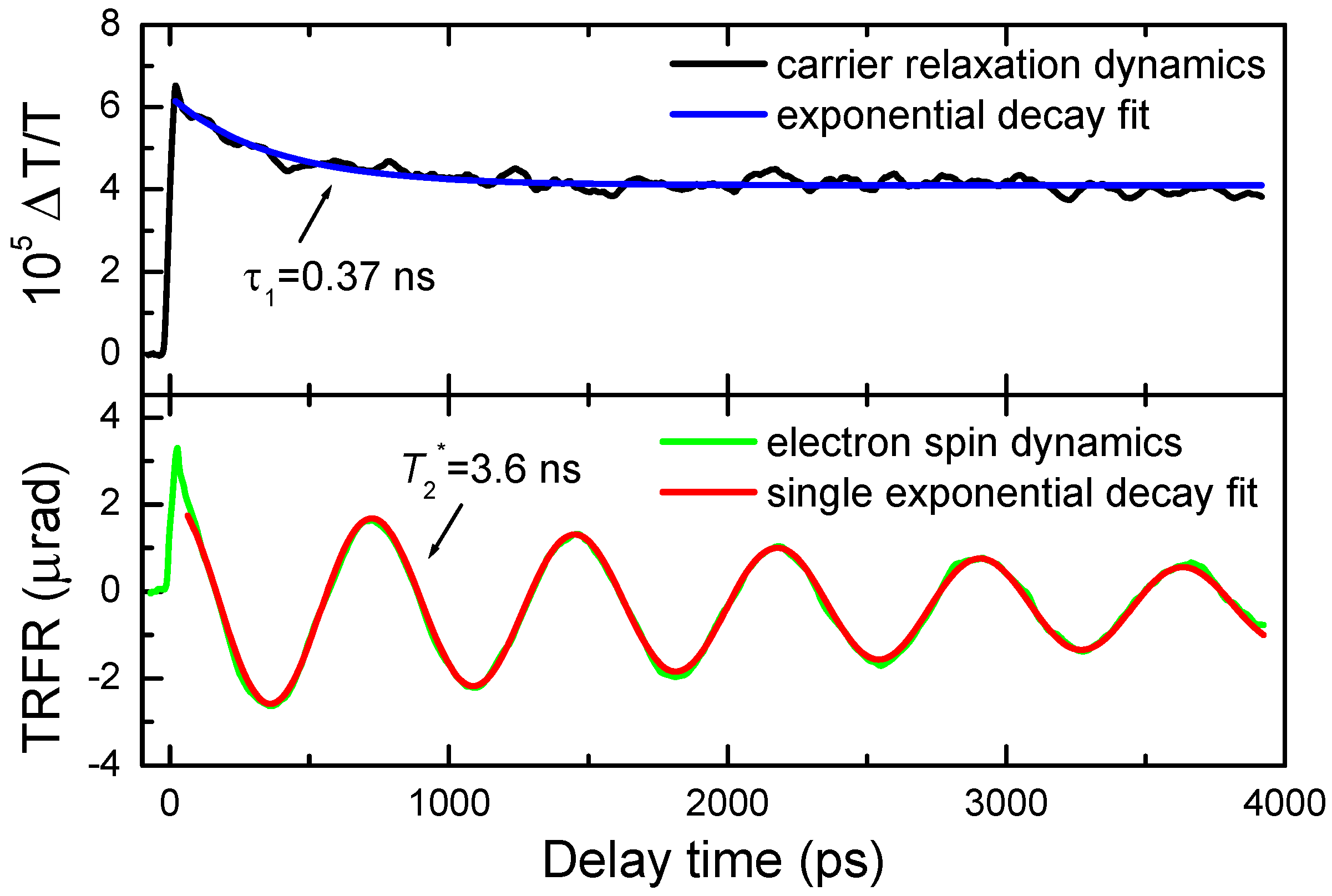
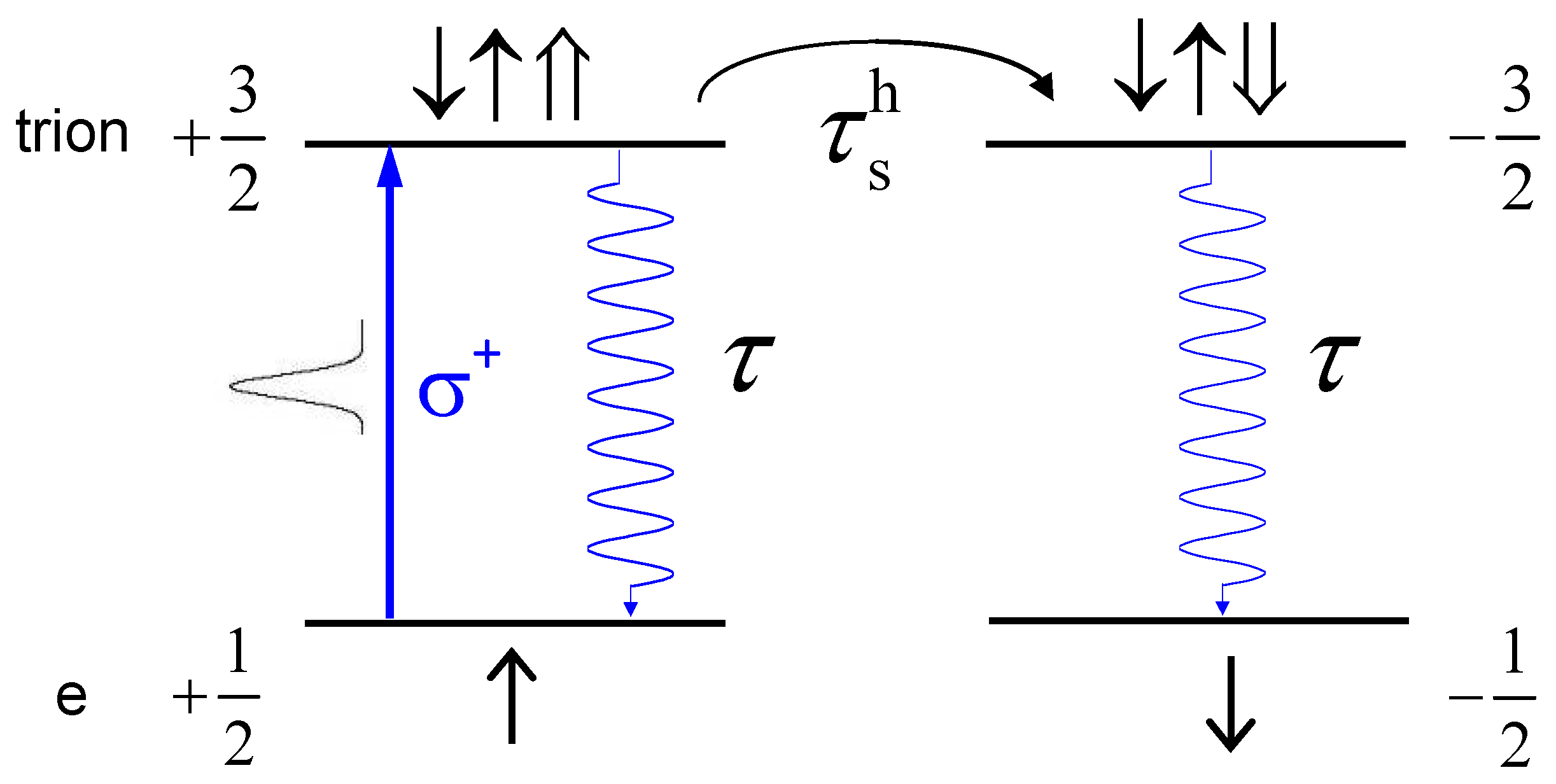
4. Conclusions
Acknowledgments
Conflicts of Interest
References
- Loss, D.; DiVincenzo, D.P. Quantum computation with quantum dots. Phys. Rev. A 1998, 57, 120–126. [Google Scholar] [CrossRef]
- Henneberger, F.; Benson, O. Semiconductor Quantum Bits; World Scientific: Singapore, 2008. [Google Scholar]
- Xu, X.D.; Wu, Y.W.; Sun, B.; Huang, Q.; Cheng, J.; Steel, D.G.; Bracker, A.S.; Gammon, D.; Emary, C.; Sham, L.J. Fast spin state initialization in a singly charged InAs-GaAs quantum dot by optical cooling. Phys. Rev. Lett. 2007, 99, 097401:1–097401:4. [Google Scholar]
- Dutt, M.V.G.; Cheng, J.; Li, B.; Xu, X.; Li, X.; Berman, P.R.; Steel, D.G.; Bracker, A.S.; Gammon, D.; Economou, S.E.; et al. Stimulated and spontaneous optical generation of electron spin coherence in charged GaAs quantum dots. Phys. Rev. Lett. 2005, 94, 227403:1–227403:4. [Google Scholar] [CrossRef]
- Ramsay, A.J.; Boyle, S.J.; Kolodka, R.S.; Oliveira, J.B.B.; Skiba-Szymanska, J.; Liu, H.Y.; Hopkinson, M.; Fox, A.M.; Skolnick, M.S. Fast optical preparation, control, and readout of a single quantum dot spin. Phys. Rev. Lett. 2008, 100, 197401:1–197401:4. [Google Scholar] [CrossRef]
- Loo, V.; Lanco, L.; Krebs, O.; Senellart, P.; Voisin, P. Single-shot initialization of electron spin in a quantum dot using a short optical pulse. Phys. Rev. B 2011, 83, 033301:1–033301:4. [Google Scholar] [CrossRef]
- Greilich, A.; Oulton, R.; Zhukov, E.A.; Yugova, I.A.; Yakovlev, D.R.; Bayer, M.; Shabaev, A.; Efros, Al.L.; Merkulov, I.A.; Stavarache, V.; et al. Optical control of spin coherence in singly charged (In, Ga)As/GaAs quantum dots. Phys. Rev. Lett. 2006, 96, 227401:1–227401:4. [Google Scholar] [CrossRef]
- Berezovsky, J.; Mikkelsen, M.H.; Stoltz, N.G.; Coldren, L.A.; Awschalom, D.D. Picosecond coherent optical manipulation of a single electron spin in a quantum dot. Science 2008, 320, 349–352. [Google Scholar] [CrossRef] [PubMed]
- Press, D.; Ladd, T.D.; Zhang, B.Y.; Yamamoto, Y. Complete quantum control of a single quantum dot spin using ultrafast optical pulses. Nature 2008, 456, 218–221. [Google Scholar] [CrossRef] [PubMed]
- Merkulov, I.A.; Efros, Al.L.; Rosen, M. Electron spin relaxation by nuclei in semiconductor quantum dots. Phys. Rev. B 2002, 65, 205309:1–205309:8. [Google Scholar] [CrossRef]
- Khaetskii, A.V.; Loss, D.; Glazman, L. Electron spin decoherence in quantum dots due to interaction with nuclei. Phys. Rev. Lett. 2002, 88, 186802:1–186802:4. [Google Scholar] [CrossRef]
- Akimov, I.A.; Feng, D.H.; Henneberger, F. Electron spin dynamics in a self-assembled semiconductor quantum dot: The limit of low magnetic fields. Phys. Rev. Lett. 2006, 97, 056602:1–056602:4. [Google Scholar]
- Feng, D.H.; Akimov, I.A.; Henneberger, F. Nonequilibrium nuclear-electron spin dynamics in semiconductor quantum dots. Phys. Rev. Lett. 2007, 99, 036604:1–036604:4. [Google Scholar]
- Syperek, M.; Yakovlev, D.R.; Yugova, I.A.; Misiewicz, J.; Sedova, I.V.; Sorokin, S.V.; Toropov, A.A.; Ivanov, S.V.; Bayer, M. Long-lived electron spin coherence in CdSe/Zn(S,Se) self-assembled quantum dots. Phys. Rev. B 2011, 84, 085304:1–085304:8. [Google Scholar]
- Liu, W.K.; Whitaker, K.M.; Smith, A.L.; Kittilstved, K.R.; Robinson, B.H.; Gamelin, D.R. Room-temperature electron spin dynamics in free-standing ZnO quantum dots. Phys. Rev. Lett. 2007, 98, 186804:1–186804:4. [Google Scholar]
- Feng, D.H.; Li, X.; Jia, T.Q.; Pan, X.Q.; Sun, Z.R.; Xu, Z.Z. Long-lived, room-temperature electron spin coherence in colloidal CdS quantum dots. Appl. Phys. Lett. 2012, 100, 122406:1–122406:4. [Google Scholar]
- Feng, D.H.; Shan, L.F.; Jia, T.Q.; Pan, X.Q.; Tong, H.F.; Deng, L.; Sun, Z.R.; Xu, Z.Z. Optical manipulation of electron spin coherence in colloidal CdS quantum dots. Appl Phys Lett. 2013, 102, 062408:1–062408:4. [Google Scholar]
- Blattner, G.; Kurtze, G.; Schmieder, G.; Klingshirn, C. Influence of magnetic fields up to 20 T on excitons and polaritons in CdS and ZnO. Phys. Rev. B 1982, 25, 7413–7427. [Google Scholar] [CrossRef]
- Gupta, J.A.; Awschalom, D.D.; Efros, Al.L.; Rodina, A.V. Spin dynamics in semiconductor nanocrystals. Phys. Rev. B 2002, 66, 125307:1–125307:12. [Google Scholar]
- Chou, H.L.; Tseng, C.H.; Pillai, K.C.; Hwang, B.J.; Chen, L.Y. Surface related emission in CdS quantum dots. DFT simulation studies. J. Phys. Chem. C 2011, 115, 20856–20863. [Google Scholar] [CrossRef]
- Note that, for a QD ensemble under the irradiation of spectrally broadened laser pulses, both spin-up and spin-down electrons will be excited by σ+ or σ− polarized light (just with unequal excitation probabilities which differs from the linearly polarized case), due to heavy-light hole mixing and allowable transitions which involves heavy, light, and split-off hole states as well. However, this only lowers the generated spin polarization but does not change the net spin orientation.
- Crooker, S.A.; Baumberg, J.J.; Flack, F.; Samarth, N.; Awschalom, D.D. Terahertz spin precession and coherent transfer of angular momenta in magnetic quantum wells. Phys. Rev. Lett. 1996, 77, 2814–2817. [Google Scholar] [CrossRef] [PubMed]
© 2013 by the authors; licensee MDPI, Basel, Switzerland. This article is an open access article distributed under the terms and conditions of the Creative Commons Attribution license (http://creativecommons.org/licenses/by/3.0/).
Share and Cite
Tong, H.; Feng, D.; Li, X.; Deng, L.; Leng, Y.; Jia, T.; Sun, Z. Room-Temperature Electron Spin Generation by Femtosecond Laser Pulses in Colloidal CdS Quantum Dots. Materials 2013, 6, 4523-4531. https://doi.org/10.3390/ma6104523
Tong H, Feng D, Li X, Deng L, Leng Y, Jia T, Sun Z. Room-Temperature Electron Spin Generation by Femtosecond Laser Pulses in Colloidal CdS Quantum Dots. Materials. 2013; 6(10):4523-4531. https://doi.org/10.3390/ma6104523
Chicago/Turabian StyleTong, Haifang, Donghai Feng, Xiao Li, Li Deng, Yuxin Leng, Tianqing Jia, and Zhenrong Sun. 2013. "Room-Temperature Electron Spin Generation by Femtosecond Laser Pulses in Colloidal CdS Quantum Dots" Materials 6, no. 10: 4523-4531. https://doi.org/10.3390/ma6104523
APA StyleTong, H., Feng, D., Li, X., Deng, L., Leng, Y., Jia, T., & Sun, Z. (2013). Room-Temperature Electron Spin Generation by Femtosecond Laser Pulses in Colloidal CdS Quantum Dots. Materials, 6(10), 4523-4531. https://doi.org/10.3390/ma6104523




